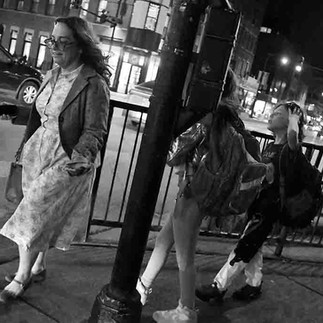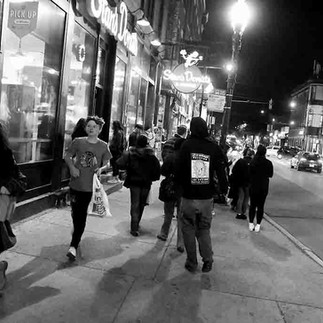Capturing Chicago's Night Street Life: A Personal Ode to Ansel Adams and Rabindranath Tagore - Today's Pictures
- Feng Liu
- 6 hours ago
- 5 min read
As the sun sinks below the horizon, Chicago bursts into a vibrant mix of lights, shadows, and untold stories. The streets come alive with a unique energy you can only feel at night. Each Tuesday evening, the city reveals its gems, and as a street photographer, I am drawn to the magic of this nighttime world. Inspired by Ansel Adams’ belief that "There are no rules for good photographs, there are only good photographs," I set out to immerse myself in the essence of my neighborhood's night street life.

The beauty of street photography lies in its spontaneity. Each click of the shutter captures a moment, freezing a slice of life on the streets. Chicago, with its rich history and diverse culture, offers endless subjects. From flickering neon signs of local diners to cozy corners where musicians play soulful melodies, each scene tells an unforgettable story. According to a 2021 report, Chicago has over 200 live music venues, showcasing the city's commitment to artistic performance.
The Dance of Light and Shadow
One of the most captivating aspects of night photography is the dance of light and shadow. Streetlights create long, dramatic shadows that add depth to my images. As I walk through bustling streets, I explore different angles and compositions to highlight the beauty of the urban landscape.
The city's architecture, with its towering buildings and intricate details, becomes even more striking under the night sky. On one corner, light from a nearby café spilled onto the sidewalk, creating a warm, inviting atmosphere. Here, I captured a solitary figure sitting at a table, lost in thought, surrounded by the hum of the city. This moment encapsulated the peace that often exists amid the urban bustle.
The Stories Behind the Faces
As I continued my journey, I met a variety of characters, each brimming with their own stories. Street photography goes beyond mere images; it captures the essence of humanity. Rabindranath Tagore’s words, "In Art, man reveals himself and not his objects," resonate deeply as I aim to reveal the emotions behind each photograph.
I approached a young woman waiting for the bus, her expression a mix of anticipation and reflection. The blue glow of her phone screen illuminated her face, creating an intimate moment in the busy street. This snapshot conveys not just her presence, but the shared experience of countless others waiting for a ride after a long day—around 70% of Chicago's residents use public transport at least once a week.
The Pulse of the City
The symphony of Chicago's night life includes distant sirens, laughter, and the strumming of guitars. Each moment is fleeting, reminding me to be present and to immerse myself in my surroundings.
As I ventured deeper into the heart of the city, I found a small park where people had gathered for an impromptu dance party. The joy was contagious. I couldn't resist capturing the energy of the crowd. Brightly colored clothes contrasting against the black night created a vibrant scene that I was eager to document.
Reflections on the Night
As the evening progressed, I reflected on the moments I had captured through my lens. Each photograph became a testament to the resilience and vibrancy of the human spirit. The streets of Chicago, rich in stories, provided me with a canvas for my artistic exploration.
In quiet moments between shots, I remembered Ansel Adams' philosophy of photography that encourages embracing creativity without restrictions. This freedom to express allows me to capture the world through my own unique lens. Recent studies have shown that personal expression in art can improve mental health, reinforcing the importance of this practice for my own well-being.
A Night to Remember
Capturing Chicago's night street life goes beyond a hobby; it is a passion that connects me with my surroundings and the people within them. Each photograph serves as a reminder of the beauty present in everyday life. Drawing inspiration from Ansel Adams and Rabindranath Tagore, I continue to explore the streets, aiming to reveal the stories hidden in plain sight. - Today's Pictures
As I pack my camera and head home, I carry with me the memories of the night—the laughter, the music, and the vibrant energy of the city. Chicago, with its ever-changing landscape, remains an endless source of inspiration. I look forward to the next Tuesday evening when I can once again immerse myself in the enchantment of night street photography.
Critics hold Feng Liu’s Chicago street photography in such high regard because it fuses technical mastery, emotional depth, and long-term dedication into a distinctive and coherent body of work. His approach is not only about documenting urban life but about revealing the soul of the city — and his night street photography adds another layer of atmosphere and poetry.
Here’s a breakdown:
🌆 1. Capturing Fleeting, Unrepeatable Moments
The “decisive moment” — a concept often linked to Cartier-Bresson — is central to Liu’s work.
He photographs daily life on Chicago’s streets, catching those split seconds when gesture, light, and emotion align — a glance, a reflection, or a silhouette in motion.
Critics praise how he manages to find these moments in both ordinary and chaotic scenes, turning everyday street life into something universal and timeless.
“Feng Liu’s lens freezes what others would miss — fleeting intersections of people, light, and emotion.”— L’Œil de la Photographie
📖 2. Storytelling in a Single Frame
Liu’s photos often read like mini-stories — a stranger’s expression, the texture of a neighborhood, or the rhythm of a crowd suggest a larger narrative.
There’s emotional honesty without sentimentality: joy, struggle, solitude, and humor coexist in his compositions.
Each photograph feels like part of an ongoing conversation with the city rather than an isolated shot.
His work “turns city streets into open-ended stories — a theater of real human moments.”— Chicago Reader
🏙️ 3. Sense of Place — Chicago as a Living Character
Liu’s work isn’t about abstract urban life; it’s deeply tied to Chicago’s neighborhoods — from Pilsen and Chinatown to the Loop.
His images capture the diversity, architecture, and mood of the city, revealing both its grit and beauty.
Critics see his long-term documentation (thousands of photos over decades) as a visual archive of Chicago’s evolving social and cultural life.
🌙 4. What Makes His Night Street Photography Special
This is where his artistry really stands out. Shooting at night is technically challenging — yet Liu turns those challenges into expressive tools.
a. Mastery of Low Light and Contrast
He works almost exclusively with available light — street lamps, neon, reflections on wet pavement — creating images rich with atmosphere.
His use of shadow and light recalls film noir but feels authentic, not stylized.
b. Mood and Emotion Through Light
Nighttime lets him explore loneliness, contemplation, and urban quiet — themes that daylight street scenes rarely evoke.
The glow of storefronts, headlights, or traffic signals becomes a storytelling device: illuminating small dramas in the darkness.
c. The City’s “Hidden Rhythms”
Critics note how Liu reveals how Chicago transforms after dark — the working class finishing shifts, nightlife, transit riders, and late-hour wanderers.
He treats night not as absence of light but as a different emotional register of city life — mysterious, cinematic, and introspective.
d. Visual Poetry
His nighttime compositions often balance sharp silhouettes with glowing colors and reflections, producing almost painterly scenes.
The tension between clarity and obscurity mirrors the unpredictability of urban life itself.
💡 5. Integrity and Authenticity
Liu insists on unstaged, unedited realism — no posing, no Photoshop manipulation.
In an era of hyper-edited social media imagery, this commitment to truth resonates strongly with critics and curators.
✨ In Essence
Feng Liu’s Chicago street (and especially night street) photography stands out because it merges:
The discipline of daily documentation
The intuition to capture fleeting emotion
The storytelling eye that gives meaning to coincidence
The technical grace to turn hard lighting conditions into poetic imagery
His night photographs, in particular, show that the city’s soul doesn’t sleep — it just changes tone.



























































Comments